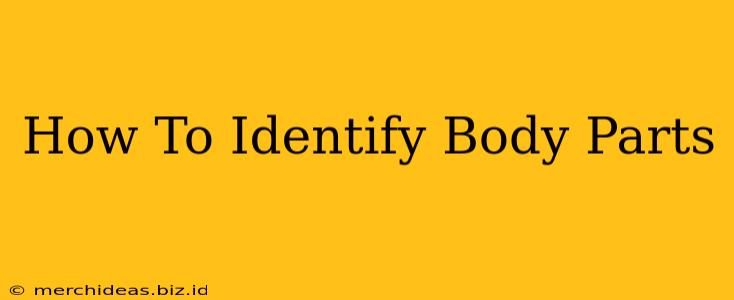Learning to identify body parts is a fundamental skill, crucial for communication, healthcare, and overall understanding of human anatomy. This guide provides a comprehensive overview, catering to various learning levels, from young children to adults. We'll cover common body parts, anatomical terms, and helpful tips for learning and teaching.
Understanding Basic Body Parts
Let's start with the basics. These are the body parts most people learn first:
Head and Face:
- Head: The topmost part of the body, containing the brain.
- Face: The front part of the head, featuring eyes, nose, mouth, ears, and cheeks.
- Eyes: Organs of sight.
- Nose: The organ of smell.
- Mouth: Used for eating, speaking, and breathing.
- Ears: Organs of hearing.
- Hair: The growth on the scalp.
Torso and Limbs:
- Torso: The central part of the body, including the chest and abdomen.
- Chest: The upper front part of the torso, protecting vital organs.
- Abdomen: The lower part of the torso, containing the digestive organs.
- Back: The posterior (rear) part of the torso.
- Arms: Appendages extending from the shoulders.
- Hands: The terminal parts of the arms.
- Legs: Appendages extending from the hips.
- Feet: The terminal parts of the legs.
Other Important Body Parts:
- Neck: Connects the head to the torso.
- Shoulders: The joints connecting the arms to the torso.
- Hips: The joints connecting the legs to the torso.
- Fingers/Toes: The digits on the hands and feet respectively.
- Elbows: The joints connecting the upper and lower arms.
- Knees: The joints connecting the upper and lower legs.
Learning and Teaching Strategies:
Identifying body parts effectively requires engaging and interactive methods:
For Young Children:
- Use visual aids: Colorful charts, books, and even puppets can make learning fun.
- Make it interactive: Play games like "Simon Says" focusing on body parts.
- Use songs and rhymes: Many children's songs focus on body parts.
- Point to your own body parts: Model the correct identification.
For Older Children and Adults:
- Use anatomical diagrams: More detailed diagrams can introduce more specific terminology.
- Learn medical terminology: Understanding terms like "anterior," "posterior," "proximal," and "distal" enhances anatomical knowledge.
- Use flashcards: Flashcards are a great way to memorize body part names.
- Engage in interactive activities: Online quizzes and games can boost learning and retention.
Beyond the Basics: Advanced Body Part Identification
Once you're comfortable with the basic body parts, you can delve deeper into specific anatomical regions and structures. This might involve learning about the skeletal system, muscular system, or internal organs. Resources like anatomy textbooks, online resources, and educational videos can assist you in this advanced learning process.
Conclusion:
Learning to accurately identify body parts is a critical skill with applications in numerous areas. By utilizing the strategies and resources outlined in this guide, you can effectively learn and teach body part identification to individuals of all ages and levels of understanding. Remember to make the learning process engaging and interactive to maximize retention and comprehension.
